crew
 Sometimes, no matter how hard the airlines work to prevent it, things go wrong. Alaskan Airlines flight 1866, which became the first fatal jet airliner crash involving Alaska Airlines, was on a routine flight from Anchorage, Alaska to Seattle, Washington. The flight was scheduled to make intermediate stops at Cordova (CDV) and Yakutat (YAK/PAYA), which it made. It was also scheduled to stop in Juneau and Sitka before ending in Seattle. Things were going along smoothly when the flight landed at Yakutat at 11:07am and then departed at 11:35am for Juneau. The flight was operated by IFR (Instrument Flight Rules). At 09:13 Flight AS1866 departed from Anchorage and landed at 09:42 in Cordova. Something was not right with the luggage upon departing Cordova, so the flight landed at Yakutat at 11:07am. Problem solved the plane took off again at 11:35am headed for Juneau.
Sometimes, no matter how hard the airlines work to prevent it, things go wrong. Alaskan Airlines flight 1866, which became the first fatal jet airliner crash involving Alaska Airlines, was on a routine flight from Anchorage, Alaska to Seattle, Washington. The flight was scheduled to make intermediate stops at Cordova (CDV) and Yakutat (YAK/PAYA), which it made. It was also scheduled to stop in Juneau and Sitka before ending in Seattle. Things were going along smoothly when the flight landed at Yakutat at 11:07am and then departed at 11:35am for Juneau. The flight was operated by IFR (Instrument Flight Rules). At 09:13 Flight AS1866 departed from Anchorage and landed at 09:42 in Cordova. Something was not right with the luggage upon departing Cordova, so the flight landed at Yakutat at 11:07am. Problem solved the plane took off again at 11:35am headed for Juneau.
What happened next, sealed the fate of all 111 people onboard the flight. The date was September 4, 1971, and it was rainy day, with low clouds. Somehow, not everyone saw the situation in the same way, but the closest accounts to reality were the ones that had the plane flying into low clouds. According to the witnesses, it then flew straight into the Chilkat Mountains in Haines Borough, near Juneau, Alaska.
The aircraft was a Boeing 727-100 with U.S. registry N2969G. It was scheduled to stop in Juneau and Sitka before ending in Seattle. The aircraft was manufactured in 1966 as c/n 19304 and manufacturer’s serial number 287. It had accumulated 11,344 flight hours prior to the incident. Seven crew members were aboard, as well as 104 passengers. The plane was told to descend and maintain 12,000 feet, and the tower asked for confirmation that the level had been maintained during a maneuver to line up for landing. He was told that the flight level had been maintained, but in reality, it couldn’t have been. At 12:00, the dispatcher repeated the permit for passing the Howard point, and also estimated the approach time as 12:10. At 12:01 Flight 1866 reported passing 12 thousand feet. At 12:07, the plane was asked about its location relative to the landing course and the waiting pattern, and the controller reported that Flight 1866 had just entered the approach scheme and followed the Howard radio beacon, after which it gave permission to descend to pass the directional beacon at a height of no more than 9 thousand feet. The crew confirmed the permission to descend and reported on leaving a height of 12 thousand feet. At 12:08, the controller asked about the altitude, with the flight responding, “…leaving five thousand five… four thousand five hundred.” Flight 1866 was then instructed to contact the Juneau ATC Tower. The crew acknowledged the transmission and then changed to the tower frequency. The tower controller said, “Alaska 66, understand, ah, I didn’t, ah, copy the intergusts to 28, the altimeter now 29.47, time is 09 112. call section, landing Runway 8, the wind 0800 at 22 occasional us by Barlow”. The crew of Flight 1866 did not respond.
“According to the testimonies of three eyewitnesses, at this time there was a little rain, and the sky was covered with clouds. According to the meteorological service of the airport, at 11:56, the sky was partly cloudy with a lower boundary of 1,500 feet and up to 3,500 feet, and up to 7,500 feet – full clouds, light rain, visibility 15 miles. Also at 1:10 pm a pilot flying from Juneau to Sitka reported weather at 11:15 – overcast, light rain, lower cloud limit 1000 feet, upper – 3000 feet, visibility 10 miles, mountain tops and passes closed. Two witnesses who were in the region of the Chilkat Mountains stated that they heard a low-flying aircraft, but  could not see it because of low visibility, which they estimated at 55-65 meters. The sound of the engines was normal. Then after a minute there was an explosion. The third witness saw a plane that disappeared into the clouds, but then did not hear any sounds. At 12:15, aircraft struck the eastern slope of a canyon in the Chilkat Range of the Tongass National Forest at the 2500-foot level, 22 miles west of Juneau. The aircraft exploded on impact.” When the crew stopped responding, at 12:23, an immediate search for Flight 1866 began. A few hours later, the wreckage of the aircraft was found on the eastern slope of the Chilkat ridge at 21.3 miles west of Juneau airport. There were no survivors.
could not see it because of low visibility, which they estimated at 55-65 meters. The sound of the engines was normal. Then after a minute there was an explosion. The third witness saw a plane that disappeared into the clouds, but then did not hear any sounds. At 12:15, aircraft struck the eastern slope of a canyon in the Chilkat Range of the Tongass National Forest at the 2500-foot level, 22 miles west of Juneau. The aircraft exploded on impact.” When the crew stopped responding, at 12:23, an immediate search for Flight 1866 began. A few hours later, the wreckage of the aircraft was found on the eastern slope of the Chilkat ridge at 21.3 miles west of Juneau airport. There were no survivors.
 B-17 crews were a tight group. Mostly these crews flew with the same crew on missions, but sometimes, someone was sick, went home, or was killed, and crews changed. For that reason, it was vital that everyone know their responsibilities. We shouldn’t write about the B-17 as a bomber without writing about the crew. In reality, the crew and their Fortress worked much like one unit. I think the crew came to love the fortress that kept them safe.
B-17 crews were a tight group. Mostly these crews flew with the same crew on missions, but sometimes, someone was sick, went home, or was killed, and crews changed. For that reason, it was vital that everyone know their responsibilities. We shouldn’t write about the B-17 as a bomber without writing about the crew. In reality, the crew and their Fortress worked much like one unit. I think the crew came to love the fortress that kept them safe.
In the cockpit, you would find the standard, pilot and co-pilot. The pilot was the commander of the crew. He was in command of the B-17, but he was also responsible for all aspects of crew training, discipline, safety and efficiency at all times, but he was more than the commander, he was also one of the crew, he wasn’t a gunner, but it was his job to bring these men home. The co-pilot was the executive officer. He must be as familiar as the pilot with all aspects of flying the B-17, ready to take over both as pilot and commander, if necessary. The B-17 required a flight crew of two to fly the plane, much like modern day jets. The co-pilot operated the instruments on the right and instruments on the left were run by the pilot. Nevertheless, in an emergency, one could fly the plane.
The navigator had the job of making sure that the plane made it to the target, and back home again. He used one or more ways of navigating: dead reckoning; using charts and visual references; pilotage, using charts along with time, distance, and speed calculations; use of radio navigation aides; and using the sun observations or at night using stars and planets. As the B-17 gets close to the target, the bombardier takes over command of the plane (including flying) as they approached the bomb target. Then, when they arrived at the target he released the bombs. Accurate bombing was crucial and that was the bombardier’s responsibility. If he wasn’t accurate, they could hit a school, a neighborhood, or other civilian area. Later on in WW II, the navigator and bombardier positions were combined into one position done by one man.
The radio operator’s job was communications, working the radios, and keeping the radios in good working order. There was a lot of radio equipment in the B-17 that allowed for both communications and navigation. He maintained a log and was often the photographer of the crew. A good radio operator knew his equipment inside out. But the radio operator was also a trained gunner. The flight engineer was one of the most important people on the plane. He knew all the equipment on the B-17 better than the pilot or any other crew member from the engines to the radio equipment to the armament to the engines to the electrical system and everything else. Many flight engineers served as maintenance crew chiefs before moving to the position of a B-17 flight engineer. The flight engineer was the final person to advise the pilot of the airworthiness of the plane before each mission. A wise pilot listened. The flight engineer doubles as top turret gunner.
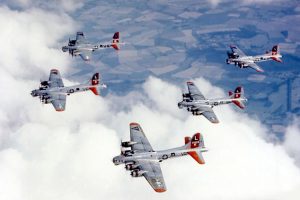 A typical crew had four gunners, sometimes less. In a configuration of four gunners there were two waist gunners (right and left), a tail gunner, and a ball turret gunner. The two waist gunners station was in the middle of the plane. As the name implies, the tail gunner’s position was in the tail and the ball turret gunner (a small man) position was in a turret underneath the B-17. Each gunner was responsible for their own armament and ensuring that their guns were in working order. Their whole job was to keep the enemy planes and enemy fire off of the B-17. So close was the relationship that these 10 men shared, that many would go on to remain friends for life, and even name their children after their respected crew mates.
A typical crew had four gunners, sometimes less. In a configuration of four gunners there were two waist gunners (right and left), a tail gunner, and a ball turret gunner. The two waist gunners station was in the middle of the plane. As the name implies, the tail gunner’s position was in the tail and the ball turret gunner (a small man) position was in a turret underneath the B-17. Each gunner was responsible for their own armament and ensuring that their guns were in working order. Their whole job was to keep the enemy planes and enemy fire off of the B-17. So close was the relationship that these 10 men shared, that many would go on to remain friends for life, and even name their children after their respected crew mates.
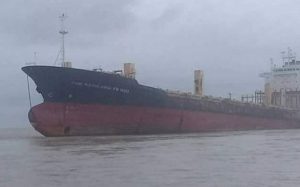 As kids, most of us hear a ghost story or two, but rarely was the “ghost” a ship. Nevertheless, ghost ships do occasionally find their way into folk lore, whether they are fact or fiction. Fictitious ghost ships would have their draw, because the storyteller can elaborate as much or as little as they want, but the non-fiction version is incredible, because it is true. One such real ghost ship is the Sam Ratulangi. This ship is a modern day version of the ghost ship. Built in 2001, the ship disappeared after only eight years of service.
As kids, most of us hear a ghost story or two, but rarely was the “ghost” a ship. Nevertheless, ghost ships do occasionally find their way into folk lore, whether they are fact or fiction. Fictitious ghost ships would have their draw, because the storyteller can elaborate as much or as little as they want, but the non-fiction version is incredible, because it is true. One such real ghost ship is the Sam Ratulangi. This ship is a modern day version of the ghost ship. Built in 2001, the ship disappeared after only eight years of service.
The disappearance is not totally unusual, but not being able to locate the ship is something else all together…especially in the year 2001. If a ship sinks, someone knows just about where to look, and with satellite coverage, someone will spot a ship that didn’t sink. And this was not small boat. The Sam Ratulangi is a huge cargo ship that is 580 feet long…not something that could be easily missed in the ocean. Nevertheless, for 9 years, there was no sign of the Sam Ratulangi. Most people assumed that the ship sank back in 2001, and gave up hope of ever finding it again.
People who love the beach, know that you often find things that have washed up on shore, but no one expected a 580 foot ship to suddenly show up within sight of the beach…bottles, driftwood, even parts of a ship wreck or plane crash, but not the whole ship, and definitely not after 9 years. Nevertheless, there it was just a 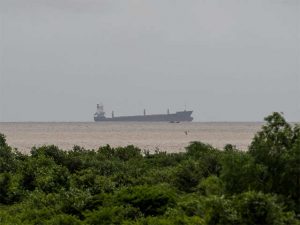 couple of miles off the coast of a village in Myanmar. The ship was empty, both of cargo and of crew. It is unknown exactly what happened to the crew. The ship is enormous, and it’s pretty hard to imagine someone not seeing this drifting out on the ocean, so why had it reappeared? It was visible from the shore, but someone had to be brave enough to go onboard to check it out. The ship was seized by the Myanmar navy, until more information could be found.
couple of miles off the coast of a village in Myanmar. The ship was empty, both of cargo and of crew. It is unknown exactly what happened to the crew. The ship is enormous, and it’s pretty hard to imagine someone not seeing this drifting out on the ocean, so why had it reappeared? It was visible from the shore, but someone had to be brave enough to go onboard to check it out. The ship was seized by the Myanmar navy, until more information could be found.
The appearance of the Sam Ratulangi was a mystery, but soon there was a clue that could lead to solving it. Radar had shown there were two ships suspiciously sailing in their waters in the preceding days. They presumed the huge ghost ship was one, but where was the other? The Navy tracked down a small tugboat called Independence, and found out that it had been transporting the huge cargo ship. After questioning the 13 crew members of the Independence, it was confirmed they had been hauling the Sam Ratulangi, but had it had been cut loose following some severe weather on the sea. They claimed they were planning on dragging the ship to Bangladesh where they would sell it to ship breakers where the vessel would be stripped down, dismantled, and anything valuable would have been salvaged. Ship breaking is pretty big business these days. Modern ships are only expected to last around 25 to 30 years before they are decommissioned due to corrosion. That leaves lots of working valuable equipment onboard these ships even if the body of the ship isn’t. Shipyards allow the owners of these ships to make some money from what is otherwise an expensive hunk of metal that will soon sink to the bottom of the ocean.
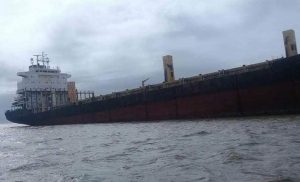
Even though the Sam Ratulangi disappeared over nine years ago, this tugboat had done what no one else apparently had, and found it in the middle of the ocean. Not willing to let this colossal ship drift around aimlessly any longer, the crew of the Independence hooked their tugboat to the Sam Ratulangi and began hauling it toward Bangladesh. So, while the mystery of how the Sam Ratulangi had disappeared, and how it avoided detection for nine years, as well as what happened to it cargo and crew, will likely never be known, the mystery of how it ended up of the Myanmar shore was solved.
 When the Apollo 11 crew landed on the moon, the world waited with unbridled excitement to view the moon rocks they were bringing back. It was an unprecedented event. Never before had man been able to look upon these space rocks. Soon, the astronauts would be treated to a ticker tape parades, and of course, the world tour to tell of their amazing escapades.
When the Apollo 11 crew landed on the moon, the world waited with unbridled excitement to view the moon rocks they were bringing back. It was an unprecedented event. Never before had man been able to look upon these space rocks. Soon, the astronauts would be treated to a ticker tape parades, and of course, the world tour to tell of their amazing escapades.
However, before all that, the astronauts had to do something that every world traveler understands…go through customs. What??? When I read that, I was stunned. Why would they need to go through customs? It’s not like they went shopping on the moon. Then again, they did bring back something they didn’t take with them…moon rocks, moon dust and other lunar samples, according to the customs form filed at the Honolulu Airport in Hawaii on July 24, 1969…the day the Apollo 11 screw splashed down in the Pacific Ocean to end their historic moon landing mission. Nevertheless, NASA had those almost immediately, didn’t they?
Apollo 11 astronauts Neil Armstrong, Buzz Aldrin and Michael Collins hd to declare the things they brought back, just like everyone else, and they had to declare not only their cargo, but also had to list their flight route as starting Cape Kennedy (now Cape Canaveral) in Florida with a stopover on the moon. Then all three men had to sign the form, so everything was legal.
The form was posted to the U.S. Customs and Border Protection Web site in 2009, to mark the Apollo 11 mission’s 40th anniversary. A copy was obtained by SPACE.com and verified by NASA. John Yembrick told SPACE.com that it was indeed authentic, was a little joke at that time, and maybe it was, but the reality is that not much has changed over the years. The big joke was the fact that because Apollo 11 splashed down 920 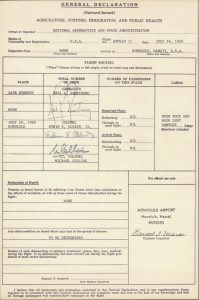 miles southwest of Hawaii and 13 miles from the USS Hornet, the Navy ship sent to recover the crew. It took two more days for the astronauts to actually return to Hawaii on July 26, where they were welcomed with a July 27 ceremony at Pearl Harbor. So customs was a bit delayed.
miles southwest of Hawaii and 13 miles from the USS Hornet, the Navy ship sent to recover the crew. It took two more days for the astronauts to actually return to Hawaii on July 26, where they were welcomed with a July 27 ceremony at Pearl Harbor. So customs was a bit delayed.
Still, the astronauts were trapped inside a NASA trailer as part of a quarantine effort. The concern was the possibility of germs they might have picked up. They had to wear special biological containment suits when they walked out on the deck of the USS Hornet after being retrieved. Then, NASA transported them to Houston, quarantine trailer and all, and they emerged from isolation three weeks later. Today’s returning astronauts exit their spacecraft almost immediately. Some, who have been in space a long time receive medical checks after spending months in the weightlessness of space. Nevertheless, today’s NASA astronauts still have to go through customs, and I still find that quite funny.
 On April 10, 1912, Titanic set sail from Southampton. Titanic called at Cherbourg in France and Queenstown (now Cobh) in Ireland before heading west to New York. For the passengers and crew, Titanic was the ultimate in luxury, and to be on it was the ultimate thrill. The ship was the most luxurious ship of its day, and to add to their sense of excitement, it was unsinkable. The passengers were assured that the ship had so many fail-safes in place that the builders didn’t even think the lifeboats were necessary, and any that were considered to be in the way, were removed, in what would prove to be a fatal mistake. In the end, there were 20 lifeboats on board the ship, when she was supposed to have 64 lifeboats. Each had a capacity of 65 people. Most lifeboats were lowered to the water with less than half their actual capacity.
On April 10, 1912, Titanic set sail from Southampton. Titanic called at Cherbourg in France and Queenstown (now Cobh) in Ireland before heading west to New York. For the passengers and crew, Titanic was the ultimate in luxury, and to be on it was the ultimate thrill. The ship was the most luxurious ship of its day, and to add to their sense of excitement, it was unsinkable. The passengers were assured that the ship had so many fail-safes in place that the builders didn’t even think the lifeboats were necessary, and any that were considered to be in the way, were removed, in what would prove to be a fatal mistake. In the end, there were 20 lifeboats on board the ship, when she was supposed to have 64 lifeboats. Each had a capacity of 65 people. Most lifeboats were lowered to the water with less than half their actual capacity.
The night of April 14, 1912 was very cold, and the route Titanic was on was littered with icebergs. Other ships 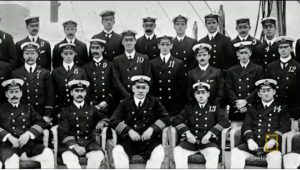 in the area tried to warn Titanic, but the radio operator of Titanic did not take the warnings seriously. He was operating under the mistaken idea that Titanic could sail right through any ice field she might come upon, and have no problems whatsoever. The radio operator was wrong. Nevertheless, he shut of the radio after the 6th warning transmission. The iceberg strike came at 11:40 pm…but the first distress call was sent almost an hour later and even then the ships receiving the calls could did not believe it could be real. Finally, at 12:40 am, Carpathia’s radio operator gave the call to head for Titanic’s last known position.
in the area tried to warn Titanic, but the radio operator of Titanic did not take the warnings seriously. He was operating under the mistaken idea that Titanic could sail right through any ice field she might come upon, and have no problems whatsoever. The radio operator was wrong. Nevertheless, he shut of the radio after the 6th warning transmission. The iceberg strike came at 11:40 pm…but the first distress call was sent almost an hour later and even then the ships receiving the calls could did not believe it could be real. Finally, at 12:40 am, Carpathia’s radio operator gave the call to head for Titanic’s last known position.
Help would come too late for Titanic. By 2:20 am on April 15, 1912, Titanic sank, but she was not without her heroes. As the Titanic was sinking, the deck crew began loading passengers onto lifeboats. The engineering crew stayed at their posts to work the pumps, controlling flooding as much as possible. This action ensured the 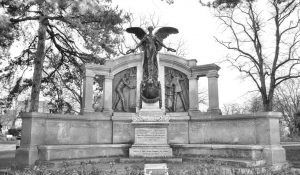 power stayed on during the evacuation and allowed the wireless radio system to keep sending distress calls. These men bravely kept at their work and helped save more than 700 people…even though it would cost them their own lives. When Titanic went down, she took with her 1500 people. of those, 688 were crew members, including all 25 of the engineers who worked tirelessly, at their own peril to buy what little bit of time they could for the passengers in their care. Many of the crew members forfeited their lives so that the passengers might live. Were serious mistakes made…yes, of course, but by the same token, the sinking of Titanic saw some of the most amazing bravery ever.
power stayed on during the evacuation and allowed the wireless radio system to keep sending distress calls. These men bravely kept at their work and helped save more than 700 people…even though it would cost them their own lives. When Titanic went down, she took with her 1500 people. of those, 688 were crew members, including all 25 of the engineers who worked tirelessly, at their own peril to buy what little bit of time they could for the passengers in their care. Many of the crew members forfeited their lives so that the passengers might live. Were serious mistakes made…yes, of course, but by the same token, the sinking of Titanic saw some of the most amazing bravery ever.
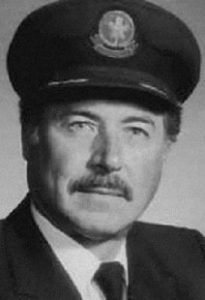
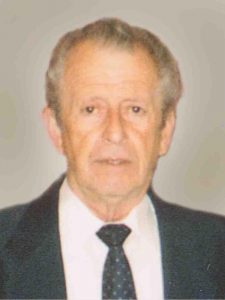 Plane crashes are always tragic events. The loss of life and property is devastating. Sometimes, however, a pilot and his crew are able to pull off a landing in unbelievable circumstances. Something like that leaves everyone from the passengers, families, the NTSB, and the world scratching their heads in disbelief. Years ago I watched a movie about just such a flight. The flight was Air Canada Flight 143. A couple of days ago, I saw that it was the 33rd anniversary of that flight which occurred on July 23, 1983, and I thought about what a miracle that whole situation was. Canada Air had just made the conversion from pounds of fuel to kilograms of fuel. Unfortunately, as is often the case in these types of conversions, things were not converting as smoothly as the airline had hoped. On 22 July 1983, Air Canada’s Boeing 767, registered as C-GAUN, c/n 22520/47, from Toronto to Edmonton where it underwent routine checks. The next day, it was flown to Montreal. Following a crew change, it departed Montreal as Flight 143 for the return trip to Edmonton via Ottawa, with Captain Robert (Bob) Pearson and First Officer Maurice Quintal at the controls. The crew had been somewhat leery of taking off with the fuel indicator taped off as inoperable. It would seem logical to most of us that Air Canada should have waited until all systems were operable before using the plane, but that was not the case.
Plane crashes are always tragic events. The loss of life and property is devastating. Sometimes, however, a pilot and his crew are able to pull off a landing in unbelievable circumstances. Something like that leaves everyone from the passengers, families, the NTSB, and the world scratching their heads in disbelief. Years ago I watched a movie about just such a flight. The flight was Air Canada Flight 143. A couple of days ago, I saw that it was the 33rd anniversary of that flight which occurred on July 23, 1983, and I thought about what a miracle that whole situation was. Canada Air had just made the conversion from pounds of fuel to kilograms of fuel. Unfortunately, as is often the case in these types of conversions, things were not converting as smoothly as the airline had hoped. On 22 July 1983, Air Canada’s Boeing 767, registered as C-GAUN, c/n 22520/47, from Toronto to Edmonton where it underwent routine checks. The next day, it was flown to Montreal. Following a crew change, it departed Montreal as Flight 143 for the return trip to Edmonton via Ottawa, with Captain Robert (Bob) Pearson and First Officer Maurice Quintal at the controls. The crew had been somewhat leery of taking off with the fuel indicator taped off as inoperable. It would seem logical to most of us that Air Canada should have waited until all systems were operable before using the plane, but that was not the case.
The flight seemed to be going smoothly, but about half way between Montreal and Edmonton, at an altitude on 41,000 feet, the aircraft’s cockpit warning system sounded, indicating a fuel pressure problem on the aircraft’s left side. Assuming a fuel pump had failed, the pilots turned it off, since gravity should feed fuel to the aircraft’s two engines. In most situations, that would have worked, but when the plane was fueled, the technician failed to accurately convert the fuel from pounds to kilograms, and the plane had run out of fuel. Running out of fuel 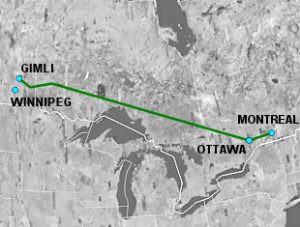 in a small plane, flying at much lower altitudes has been known to get people killed, but this was a Boeing 767, and it was at an altitude of 41,000 feet. This had all the makings of a disaster…but somehow, that was not what happened. In this case, the event would prove to be the finest hour for the pilot and crew.
in a small plane, flying at much lower altitudes has been known to get people killed, but this was a Boeing 767, and it was at an altitude of 41,000 feet. This had all the makings of a disaster…but somehow, that was not what happened. In this case, the event would prove to be the finest hour for the pilot and crew.
The passengers on this plane had the unusual advantage of having at the controls, a pilot who was an experienced glider pilot. Now, as you know gliders have no fuel in them. You are pulled into the air by another plane and then released to glide in for a landing. That’s an easy enough task for a trained glider pilot in a glider plane, but this was a modern day, wide body jet. The idea of gliding this plane in for a safe landing was…well, unheard of. Robert “Bob” Pearson was that pilot, and with the help of his crew and an air traffic controller, he safely glided the plane into an abandoned Royal Canadian Air Force airstrip that was being used as a drag strip…at the very moment of the landing of the plane. The men could not see that, however, until they were almost on top of the people. Thankfully, the people on the runway saw the plane and got out of the way.
The crew had hoped to make Winnipeg, but with the best glide speed and the rate of descent, there was no way. Then, Quintal remembered Gimli, and the abandoned strip became their last hope. They were too high for it, so Pearson performed a slip, which is a glide maneuver to increase drag, causing the plane to lose altitude quickly. To add to the problem, the nose gear came down, but did not lock as the rest of the gear had. Could things have been more dire? In the end, Captain Pearson executed the landing perfectly, in spite of all of the problems, and the fact that the Winnipeg Sports Car Club was on the field with everything needed to assist in 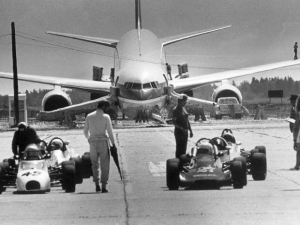
 this emergency, the plane landed without a single death in the plane or on the ground, and the fuel starvation scenario became part of the pilots training in their simulators. The first pilots to try the program in the simulator all crashed, and believed that it was an impossible scenario, until they were told that it had happened, and that the pilot landed safely. The flight has since been dubbed the Gimli Glider. And, that’s a miracle for the books.
this emergency, the plane landed without a single death in the plane or on the ground, and the fuel starvation scenario became part of the pilots training in their simulators. The first pilots to try the program in the simulator all crashed, and believed that it was an impossible scenario, until they were told that it had happened, and that the pilot landed safely. The flight has since been dubbed the Gimli Glider. And, that’s a miracle for the books.
 Inspiration comes from many different places, but most often from an event that so strongly affects our emotions or our lives, that we feel the need to act. That is what happened to a number of students who all had something in common…Christa McAuliffe. On this day, January 28, 1986…30 years ago, after months of training and a huge national following, Christa McAuliffe entered the Space Shuttle Challenger, and went down in history as not only the first teacher chosen to go into space, but the first civilian to die on such a mission. She never made it into space, because just 73 seconds after the launch, the Challenger exploded.
Inspiration comes from many different places, but most often from an event that so strongly affects our emotions or our lives, that we feel the need to act. That is what happened to a number of students who all had something in common…Christa McAuliffe. On this day, January 28, 1986…30 years ago, after months of training and a huge national following, Christa McAuliffe entered the Space Shuttle Challenger, and went down in history as not only the first teacher chosen to go into space, but the first civilian to die on such a mission. She never made it into space, because just 73 seconds after the launch, the Challenger exploded.
The world looked on in horror, because this launch had been so widely televised and so greatly anticipated.  After the explosion, the news was broadcast over and over. We saw the horrified faces of the families of the crew, the tears of family, friends, and students of the first teacher in space, and we saw the explosion…over and over again. The heart of a nation was broken, not just because of Christa McAuliffe, but also for the families of payload specialist Gregory Jarvis; and astronauts Judith A. Resnik, mission specialist; Francis R. (Dick) Scobee, mission commander; Ronald E. McNair, mission specialist; Mike J. Smith, pilot; and Ellison S. Onizuka, mission specialist. It had been many years since the NASA space program had lost a crew, and it was the first one in flight.
After the explosion, the news was broadcast over and over. We saw the horrified faces of the families of the crew, the tears of family, friends, and students of the first teacher in space, and we saw the explosion…over and over again. The heart of a nation was broken, not just because of Christa McAuliffe, but also for the families of payload specialist Gregory Jarvis; and astronauts Judith A. Resnik, mission specialist; Francis R. (Dick) Scobee, mission commander; Ronald E. McNair, mission specialist; Mike J. Smith, pilot; and Ellison S. Onizuka, mission specialist. It had been many years since the NASA space program had lost a crew, and it was the first one in flight.
I’m sure that an accident in space did not inspire people to go into the space program, because the safety of the program immediately came into question. Nevertheless, from this tragedy…from out of the ashes of the Space Shuttle Challenger, inspiration did come. It came in the form of teachers. The students of Christa  McAuliffe…not all, but a number of them, were inspired to become teachers themselves. Each of those former students of Christa McAuliffe…kids who maybe didn’t like social studies, but because Christa McAuliffe made it interesting somehow, they did well in her class, and were inspired by her. After her passing, these inspired students decided that they wanted to pick up where she left off. They wanted to carry on with her dream. They follow her motto, “I touch the future. I teach.” One of those teachers commented that she heard people say that and wondered if they had any idea where that motto came from. Her former students knew…it was Christa McAuliffe, and her legacy lives on, 30 years after her death.
McAuliffe…not all, but a number of them, were inspired to become teachers themselves. Each of those former students of Christa McAuliffe…kids who maybe didn’t like social studies, but because Christa McAuliffe made it interesting somehow, they did well in her class, and were inspired by her. After her passing, these inspired students decided that they wanted to pick up where she left off. They wanted to carry on with her dream. They follow her motto, “I touch the future. I teach.” One of those teachers commented that she heard people say that and wondered if they had any idea where that motto came from. Her former students knew…it was Christa McAuliffe, and her legacy lives on, 30 years after her death.
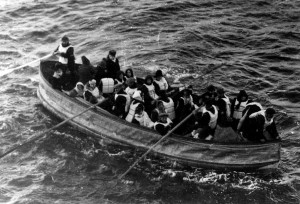 Whenever a big train wreck, plane crash, ship sinking, or other major accident occurs, someone must investigate. Depending on what happened, it can be someone like the NTSB, or in some cases, as in the Titanic sinking, it can go as high as the Senate. Of course, answers need to be found, so that corrections in procedure can be made.
Whenever a big train wreck, plane crash, ship sinking, or other major accident occurs, someone must investigate. Depending on what happened, it can be someone like the NTSB, or in some cases, as in the Titanic sinking, it can go as high as the Senate. Of course, answers need to be found, so that corrections in procedure can be made.
In the case of the Titanic, the accident was brought before the Senate Commerce Committee. I think most of us know the story of the Titanic well, given the movies and documentaries that have come out about it. The official final report, however, went into much more detail than most people know about, and more than I can go into here. I think most of us know that the ship was not sufficiently run through the test trials to properly break in the engines. Nevertheless, the Titanic was run at full speed through trecherous waters, without regard for the damage that could have come to pass.
In addition to this problem, it was noted that many of the crew members did not join the ship until just a few hours before it sailed, and the only drill carried out, consisted of lowering just two lifeboats on the starboard side into the water. There was no boat list designating the stations members of the crew were posted to until several days after sailing. This left the crew in ignorance of their stations until the following Friday morning. Of course, as we all know, there were not enough lifeboats on the ship, because it was thought to clutter the deck, and to be unnecessary. In reality there were only boats enough for only 1,176 of the 2,228 people on board…and of those, only 710 survived, meaning that lifeboats were lowered only partially loaded. Had the Titanic been loaded to full capacity, which was 3,339 passengers and crew, there would have only been room for a third of the people on the lifeboats. and as was the case of only loading the lifeboats half full, 2,629 people would have died.
It was the conclusion of the Senate Commerce Committee, that there were several areas of gross negligence  on the part of White Star Line and the crew of the Titanic. In fact the committee was actually appalled, as it should have been. They called the Titanic, and unnecessary tragedy. Improperly trained crew and improper procedures, can be a deadly mix, and as was the case with Titanic, death is what ensued. Many laws have changed as a result of the hearings, but I have to wonder why it takes such a devastating accident to bring about a proper, concervative apporoach to the handling of many areas of transportation, construction, and work ethic. To me, it seems a little late to try to put proper safety methods in place when the ship has already sunk, but then I guess it does protect those who will come after.
on the part of White Star Line and the crew of the Titanic. In fact the committee was actually appalled, as it should have been. They called the Titanic, and unnecessary tragedy. Improperly trained crew and improper procedures, can be a deadly mix, and as was the case with Titanic, death is what ensued. Many laws have changed as a result of the hearings, but I have to wonder why it takes such a devastating accident to bring about a proper, concervative apporoach to the handling of many areas of transportation, construction, and work ethic. To me, it seems a little late to try to put proper safety methods in place when the ship has already sunk, but then I guess it does protect those who will come after.

